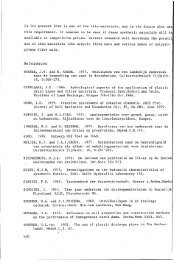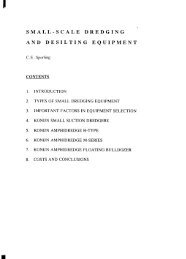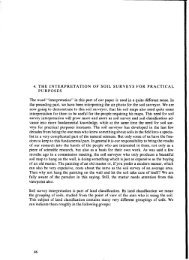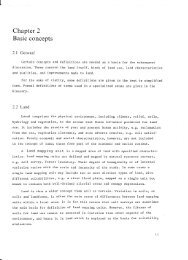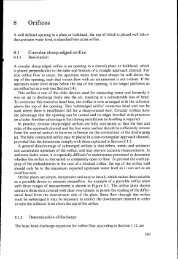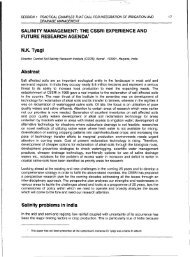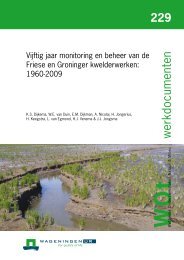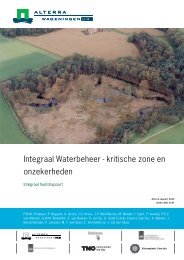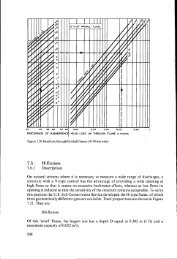Environmental aspects of acid sulphate soils - ROOT of content
Environmental aspects of acid sulphate soils - ROOT of content
Environmental aspects of acid sulphate soils - ROOT of content
Create successful ePaper yourself
Turn your PDF publications into a flip-book with our unique Google optimized e-Paper software.
differ from Fe-rich <strong>acid</strong> <strong>sulphate</strong> <strong>soils</strong> in their behaviour after flooding and reduction,as discussed below.Reduction processesReduction <strong>of</strong> redox elements that are common in <strong>soils</strong>, such as Fe, Mn, S, and N,consumes protons and is responsible for the increase in pH commonly observed in<strong>acid</strong> <strong>soils</strong> after waterlogging. Increased pH upon flooding is the main reason whywetland rice cultivation is succesful on <strong>acid</strong> <strong>sulphate</strong> <strong>soils</strong>. While the increase in pHand associated decrease in dissolved Al3+ are favourable for the crop, other changesfollowing reduction are not. These include the formation <strong>of</strong> other potentially toxicsubstances, such as Fe2+, organic <strong>acid</strong>s and HzS, in the course <strong>of</strong> soil reduction. Moreover,soil reduction or pH increase following soil reduction are <strong>of</strong>ten limited in <strong>acid</strong><strong>sulphate</strong> <strong>soils</strong>.Reduction <strong>of</strong> Fe111 and its chemical consequencesIn most moderately <strong>acid</strong> <strong>soils</strong> (pH 4-6), waterlogging causes an increase in pH to avalue between 6 and 7 after several weeks <strong>of</strong> flooding. Usually, reduction <strong>of</strong> Fe(ll1)to Fe(I1) is quantitatively the most important process involved in this rise in pH (Ponnamperuma1972, Patrick and Reddy 1978).Equation 5 illustrates that protons are consumed in the reduction <strong>of</strong> Fe(I1I) oxides,with organic matter (‘CH,O’) as the electron donorFe20~+ 1/2CH,O(,,) + 4H+(,,, + 2Fe2+Cdq) + 1/2COz,g,,,) + 5/2Hz0,,) (5)Hypothetical changes in pH and the concentration <strong>of</strong> Fe2+ upon reduction <strong>of</strong> <strong>soils</strong>with various proton donors are indicated in Figure I. In <strong>acid</strong> <strong>sulphate</strong> <strong>soils</strong>, theseprotons can be derived from free sulphuric <strong>acid</strong> and desorption <strong>of</strong> adsorbed <strong>sulphate</strong>,producing soluble ferrous <strong>sulphate</strong>, according to pathway d. In <strong>acid</strong> <strong>soils</strong> with littlefree <strong>acid</strong>ity and <strong>sulphate</strong>, hydroxylation <strong>of</strong> exchangeable Al3+ during reduction <strong>of</strong>FeIII produces Al hydroxide plus exchangeable FeZ+ (pathway a). In slightly <strong>acid</strong>to near neutral conditions, CO, may serve as a proton donor, producing HCOq plussoluble Fe2+ (pathway c), part <strong>of</strong> which may be exchanged for other cations (pathwayb). The increase in pH and in the concentration <strong>of</strong> dissolved Fe2+ stops when saturationwith ‘Fe(OH),’ has been reached. By that time, <strong>acid</strong> <strong>sulphate</strong> <strong>soils</strong> have a somewhatlower pH and much higher levels <strong>of</strong> dissolved Fe2+ (pathway d-c) than <strong>acid</strong> ‘non<strong>sulphate</strong>’<strong>soils</strong> (pathway a-c), and than slightly <strong>acid</strong> <strong>soils</strong> with appreciable amounts<strong>of</strong> exchangeable bases (pathway b). Sulphate reduction, which may follow reduction<strong>of</strong> FeIII, produces HzS and HCO). This causes a further increase in pH but tendsto decrease dissolved Fe2+ by precipitation <strong>of</strong> FeS so that, ultimately, pH and dissolvedFe in flooded <strong>acid</strong> <strong>sulphate</strong> <strong>soils</strong> may reach the same values as in ‘normal’ flooded<strong>soils</strong>.In most moderately <strong>acid</strong> wetland rice <strong>soils</strong>, the pH rises to equilibrium values between6.5 and 7 within a few weeks <strong>of</strong> flooding. The same is true for many very young<strong>acid</strong> <strong>sulphate</strong> <strong>soils</strong>, where an increase in pH from 3-3.5 to 5.5-6 is associated with‘Fe(OH)2’ is a proxy for the unknown Fell-containing hydroxide precipitates which form the bulk <strong>of</strong>solid Fe11 in most seasonally-reduced <strong>soils</strong>, with an apparent solubility product <strong>of</strong> about (van Breemenand Moormann 1978)396



